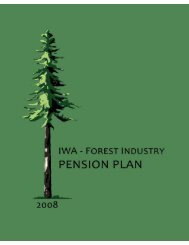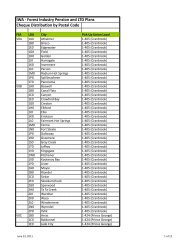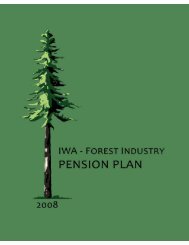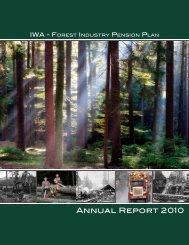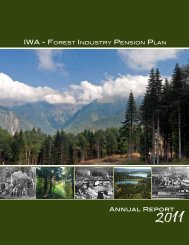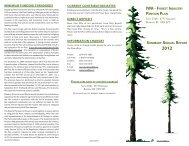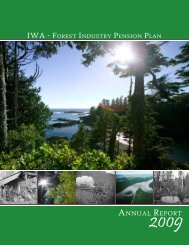2008 Annual Report - IWA Forest Industry Pension Plan
2008 Annual Report - IWA Forest Industry Pension Plan
2008 Annual Report - IWA Forest Industry Pension Plan
Create successful ePaper yourself
Turn your PDF publications into a flip-book with our unique Google optimized e-Paper software.
<strong>IWA</strong> - FOREST INDUSTRY PENSION PLANANNUAL REPORT<strong>2008</strong>
<strong>IWA</strong> - FOREST INDUSTRY PENSION PLANSuite 150 - 2955 Virtual WayVancouver BC V5M 4X6CITY OF VANCOUVER ARCHIVES, LOG P47 [C. 1924]Main Switchboard: 604-433-6310Toll Free in BC: 1-800-663-4384<strong>Pension</strong> Info: 604-433-5862<strong>Pension</strong> Toll Free: 1-800-913-0022Facsimile: 604-433-0518Website: www.iwafibp.caBLACK AND WHITE COVER PHOTOS:CITY OF VANCOUVER ARCHIVESINDUST P10 [C. 1942]LP 255.18 [BETWEEN 1910 AND 1914]
TABLE OF CONTENTSMESSAGE FROM THE TRUSTEES 1PROFILE 2A BRIEF REVIEW OF <strong>2008</strong> 3PENSION PLAN GOVERNANCE 4OVERVIEW 4GOVERNANCE PRACTICES 4BOARD COMMITTEES 5BOARD CHANGES 5GOVERNANCE STRUCTURE 6MEMBERSHIP 7ACTIVE MEMBER PROFILE 8RETIRED MEMBER PROFILE 8HISTORICAL MEMBERSHIP TRENDS 9INVESTMENT INFORMATIONASSETS IN THE PENSION FUND 10ASSET MIX 11RATES OF RETURN AND BENCHMARKS 12INVESTMENT MANAGERS 14TOP TEN HOLDINGS 14FINANCIAL INFORMATIONGOING CONCERN ACTUARIAL LIABILITY 15SOLVENCY LIABILITY 16SUMMARIZED FINANCIAL STATEMENTS FOR <strong>2008</strong> 17BENEFIT PAYMENTS 19OPERATING EXPENSES 19INVESTMENT AND CUSTODIAL FEES 20ANNUAL CASH FLOW 20CONTRIBUTORY HOURS 21GLOSSARY 22
MESSAGE FROM THE TRUSTEESWithout a doubt, <strong>2008</strong> was a challenging and disappointing year for capital markets around the world. The global economyexperienced profound disruption and global equity markets dropped by 30 – 40 per cent. The <strong>IWA</strong> - <strong>Forest</strong> <strong>Industry</strong> <strong>Pension</strong> <strong>Plan</strong>’s<strong>2008</strong> results reflect these unusually difficult conditions. Like most major institutional investors, the <strong>Plan</strong> experienced an investmentloss in <strong>2008</strong> as the global financial crisis led to a sharp decline in global equity and credit markets. The <strong>Plan</strong>’s investment portfolioloss for <strong>2008</strong> was 18.4 per cent. Although this is only our second loss in the last 18 years, it is our most significant.There is a great deal of understandable and appropriate anxiety about where we are headed. However, looking beyond the currentglobal financial crisis, there remains good reason to be fairly optimistic. Research shows that even with periods of extreme volatility,the performance of investment markets evens out over time. And, even though it is difficult to put a positive spin on this pastinvestment year, it is important to remember that markets will rise and fall and it is long-term performance that is most importantfor pension plans. In spite of the negative results in <strong>2008</strong>, a positive average rate of return for the past ten years of 5.6 per cent wasrealized. This gain is in excess of the <strong>Plan</strong>’s ten year benchmark of 4.3 per cent and has added over $677 million in value since 1998for our nearly 75,000 <strong>Plan</strong> members.Change is inevitable. With it, however, comes the opportunity to grow and strengthen our investment decisions and continue withour commitment to our members.TOM GETZIE, CO-CHAIRBOB MATTERS, CO-CHAIR<strong>IWA</strong> - <strong>Forest</strong> <strong>Industry</strong> <strong>Pension</strong> <strong>Plan</strong><strong>Annual</strong> <strong>Report</strong> <strong>2008</strong>1
PROFILEThe <strong>IWA</strong> – <strong>Forest</strong> <strong>Industry</strong> <strong>Pension</strong> <strong>Plan</strong> (the “<strong>Plan</strong>”) was established in 1973 pursuant to negotiations between the I.W.A. and<strong>Forest</strong> <strong>Industry</strong> employers, to provide benefits for workers in the forest industry. In 1978 the Coast, Southern Interior and NorthernInterior regional pension plans were merged to create the current <strong>Plan</strong>. In September of 2004 the I.W.A. merged with the UnitedSteelworkers (“USW”) and now the forest industry employees are members of the USW. Today our <strong>Plan</strong> serves over 70,000 currentand retired members in the industry.The <strong>Plan</strong> provides two major services: It acts as benefit administrator by collecting contributions and administering payment ofbenefits, and it also serves as the investment manager of the <strong>Plan</strong>’s assets (the “<strong>Pension</strong> Fund”).ADMINISTRATIVE FUNCTIONS: Employer enrolment and collection of information. Collection of contributions from both participating employers and <strong>Plan</strong> members. Benefit calculations and processing. Providing information to members, union locals and participating employers on pension benefits. Payment of benefits. Filing of appropriate documentation for tax and pension regulatory purposes.INVESTMENT FUNCTIONS: Evaluate risk and return opportunities between the <strong>Plan</strong>’s assets and liabilities. Establish and recommend appropriate investment mix and long-term investment benchmarks. Use investment policy to review and monitor independent investment manager performance and make changes asappropriate. Use independent custodian for safekeeping of <strong>Plan</strong> assets. Use staff and independent consultants to review <strong>Plan</strong> investment strategies and ensure compliance with <strong>Plan</strong> policiesand regulatory compliance.The <strong>Plan</strong> employs approximately 40 employees at our offices in Vancouver, B.C. and is governed by the provisions of the <strong>Pension</strong>Benefits Standards Act of British Columbia.<strong>IWA</strong> - <strong>Forest</strong> <strong>Industry</strong> <strong>Pension</strong> <strong>Plan</strong><strong>Annual</strong> <strong>Report</strong> <strong>2008</strong>2
A BRIEF REVIEW OF <strong>2008</strong>MEMBER SERVICES There were 21,361 active members in the <strong>Plan</strong> as at December 31, <strong>2008</strong>. There were 29,645 inactive members in the <strong>Plan</strong> as at December 31, <strong>2008</strong>. 1,360 members retired in <strong>2008</strong>. A total of 22,712 retirees and beneficiaries received monthly pensions totalling in excess of $172 million dollars for<strong>2008</strong>. 3,271 members broke service at the end of <strong>2008</strong>. The average monthly pension payment for <strong>2008</strong> was $630.06. Over 273 beneficiary claims were processed. Over 18,900 telephone calls were received in member services. 27 retirement seminars were conducted across British Columbia. 295 personal interview sessions were conducted with our pension counsellors at our offices in Vancouver. Over 4,600 estimates were provided to our membership. Our website reported over 476,000 hits by year end <strong>2008</strong>, with 11,655 visitors.PLAN HIGHLIGHTS There are currently 437 participating employers in the <strong>Plan</strong>; 11 employers began participating in the year <strong>2008</strong>. Approximately $57.9 million was contributed to the <strong>Plan</strong> by participating employers and $31.7 million by employees. There were 1,731 commuted value withdrawals from the <strong>Pension</strong> Fund at a value of $26.2 million. As of December 31, 2006 (the last filed actuarial valuation), there was a solvency liability of $3.372 billion, and a solvencyratio of 94%. As of December 31, 2006 (the last filed actuarial valuation), there was a going concern liability of $2.912 billion, and afunded ratio of 103.6%. Employee contribution levels were increased from $1.375 to $1.625 per hour at July 1, <strong>2008</strong> for the majority of participatingemployers. Our Board of Trustees met 10 times during the calendar year. Over 21 million hours were reported for <strong>2008</strong> (2007 had 27.6 million hours). Payments to retired members and beneficiaries increased by $9.3 million from last year.INVESTMENT HIGHLIGHTS The market value of the Fund dropped from $3.21 billion to $2.51 billion at year-end. The annual rate of return on investments was -18.4%.<strong>IWA</strong> - <strong>Forest</strong> <strong>Industry</strong> <strong>Pension</strong> <strong>Plan</strong><strong>Annual</strong> <strong>Report</strong> <strong>2008</strong>3
PENSION PLAN GOVERNANCEOVERVIEWA 16 member Board of Trustees equally representing both the United Steelworkers and the <strong>Forest</strong> <strong>Industry</strong> employers oversees theadministration of the <strong>Plan</strong>. The <strong>Plan</strong>’s sponsors are responsible for appointing the Trustees to operate the <strong>Plan</strong> and manage theFund in the long-term interest of the <strong>Plan</strong> membership.The appointed Trustees are responsible for determining <strong>Plan</strong> benefit levels and <strong>Plan</strong> design. They acquire and manage the servicesof the administrators, actuaries, auditors, legal counsel, investment managers and custodians in order to ensure the security ofthe <strong>Pension</strong> Fund and competent administration of members’ pensions. The <strong>Plan</strong> is provincially regulated and governed by theprovisions of the <strong>Pension</strong> Benefits Standards Act of British Columbia.GOVERNANCE PRACTICESThe role of a Trustee is complex and good governance practices are necessary to ensure the <strong>Plan</strong>’s goals are achieved. <strong>Pension</strong> plangovernance refers to the structure and processes adopted by the Board of Trustees for overseeing, managing and administeringthe <strong>Plan</strong>. The objective of good governance is to optimize the <strong>Plan</strong>’s performance while ensuring that the <strong>Plan</strong> is able to meet itsobligations to its members and beneficiaries.The Trustees of the <strong>Plan</strong> are required to act independently of the United Steelworkers and <strong>Forest</strong> <strong>Industry</strong> participating employersto make decisions in the best interest of our <strong>Plan</strong> members and beneficiaries. Through its ongoing commitment to goodgovernance practices the Board has strategies in place to provide guidance, measure effectiveness and ensure accountability andtransparency. Committee Terms of Reference: Reviewed and accepted guidelines for Trustee and staff roles and responsibilities asrelated to investment, administration, actuarial and audit issues. Committee Structure: Committees created to focus on the different roles and responsibilities of Board Trustees. Eachcommittee meets anywhere from one to four times per year. Ad hoc committees, to deal with short term specific issues,are established on an as needed basis. Code of Conduct Policy: Developed to articulate and sustain a governance and corporate culture that reflects theBoard’s principles and values, and to ensure that Trustees have a full understanding of these principles and values. Board Education and Qualification: Orientation and external training for new and existing Trustees to educate andassist them in carrying out their governance responsibilities. Comprehensive Trustee Governance Manual designed toassist Board members on current training requirements and standards of practice. Board Effectiveness Assessment Process: Self-assessment process required annually which is designed to provideTrustees with an opportunity to examine how the Board is operating and to make suggestions for improvement. Communication: The Board communicates to the union, participating employers and membership regularly throughaudited financial statements, actuarial valuations, this report, annual statements issued to members, our website, onsite seminars and through our member services via local and toll free phone lines.<strong>IWA</strong> - <strong>Forest</strong> <strong>Industry</strong> <strong>Pension</strong> <strong>Plan</strong><strong>Annual</strong> <strong>Report</strong> <strong>2008</strong>4
PENSION PLAN GOVERNANCEBOARD COMMITTEESThe committees are made up of Trustees with equal representation from participating <strong>Forest</strong> <strong>Industry</strong> employers and the UnitedSteelworkers.Audit CommitteeThe Audit Committee assists in the supervision of the <strong>Plan</strong>’s internal operations, reviews the audited financial reports, meetswith external auditors, and ensures information disclosure, accuracy and efficiency thereby building confidence with <strong>Plan</strong>members, <strong>Plan</strong> sponsors and regulators.Investment CommitteeThe Investment Committee oversees the investment of the <strong>Pension</strong> Fund. It reviews and advises the Trustees as to selectionof investment managers, matters of investment policy, <strong>Pension</strong> Fund asset management and any other matters relating to theinvestment and management of the <strong>Pension</strong> Fund.Governance CommitteeThe Governance Committee reviews the system of governance including the mandates for the Board and committees, bestpractices for <strong>Plan</strong> governance and the effectiveness of the Board and its committees.Human Resources & Compensation CommitteeThe Human Resources & Compensation Committee establishes compensation, including compensation policies and strategies,for the General Manager and the Director, Investments as well as compensation policies and strategies for employees excludedfrom the bargaining unit. It also reviews labour relations, strategy, succession planning and key employee development.BOARD CHANGESThere were no changes to the Board of Trustees last year.<strong>IWA</strong> - <strong>Forest</strong> <strong>Industry</strong> <strong>Pension</strong> <strong>Plan</strong> 5<strong>Annual</strong> <strong>Report</strong> <strong>2008</strong>
GOVERNANCE STRUCTURE<strong>IWA</strong> - FOREST INDUSTRY PENSION PLANBOARD OF TRUSTEESTom Getzie (1, 2, 3*, 4*)Co-Chair<strong>Forest</strong> Industrial RelationsBob Matters (1*, 2*, 3*, 4*)Co-ChairUnited SteelworkersMike Bryce (3)CONIFERVern Carter (2*)I.F.L.R.A.Frank Everitt (1, 2)USWBill Routley (1)USWDonald Cadman (1*, 3, 4)CONIFERNorman Chow (1)I.F.L.R.A.Brian HarderUSWDoug SingerUSWBrian Cairo (2)FIRTerry LinekerFIRMonty MearnsUSWDarrel Wong (1, 2, 3, 4)USWWarren OjaUSWHarvey Arcand, Advisor - USWGerry Smith, Advisor - USWADMINISTRATION & INVESTMENTSRobert BishoffGeneral ManagerColleen TroelstrupDirector, InvestmentsJudith Brown<strong>Pension</strong> AdministratorTRUST FUND CUSTODIAN PLAN ACTUARY AUDITORSRBC Dexia Investor Services TOWERS PERRIN, INC. GRANT THORNTON LLPEXTERNAL LEGAL COUNSELLAWSON LUNDELL LLPINVESTMENT CONSULTANTRUSSELL INVESTMENTS CANADA LIMITED1 Audit Committee1* Audit Committee Co-Chair2 Investment Committee2* Investment Committee Co-Chair3 Governance Committee3* Governance Committee Co-Chair4 Human Resources & Compensation Committee4* Human Resources & Compensation Committee Co-Chair<strong>IWA</strong> - <strong>Forest</strong> <strong>Industry</strong> <strong>Pension</strong> <strong>Plan</strong><strong>Annual</strong> <strong>Report</strong> <strong>2008</strong>Appointing Organizations:I.F.L.R.A.Interior <strong>Forest</strong> Labour Relations AssociationCONIFERCouncil on Northern Interior <strong>Forest</strong> Employment RelationsFIR<strong>Forest</strong> Industrial RelationsUSWUnited Steelworkers6
MEMBERSHIPThe <strong>Plan</strong> holds the pension assets of over 70,000 members, from 437 participating employers and is considered the largest privatesector pension plan in British Columbia.<strong>2008</strong> 2007 2006Active Members 21,361 24,256 26,375Inactive Members 29,645 28,598 27,224Retired Members 22,712 22,072 21,386Market Value of Funds (millions) $2,513.2 $3,212.7 $3,179.9Employer Contributions (millions) $57.9 $74.4 $93.7Employee Contributions (millions) $31.7 $33.7 $36.4Retirement Benefits Paid (millions) $172.1 $162.0 $154.3Value of Members Accounts transferred out of <strong>Plan</strong>(millions)$26.2 $21.8 $17.8<strong>Annual</strong> Administrative Cost per Member(excludes investment cost)$57.30 $53.22 $51.46The annual administrative cost per member increased slightly last year to $57.30. This cost has remained relatively stable, averaging$52.69 per member over the last 5 years.MEMBERSHIP BREAKDOWN <strong>2008</strong> AND 19881988 <strong>2008</strong>29%Active(21,361)66%Active(49,384)40%Inactive(29,645)19%Inactive(14,286)31%Retirees &Beneficiaries(22,712)15%Retirees &Beneficiaries(11,549)0 10,000 20,000 30,000 40,000 50,000 60,000 70,000 80,000The number of pensioners has nearly doubled in the past 20 years, while the number of active members declined by more than 50%- in part due to greater global competition, the rapid pace of technological change and automation within the forest industry. Themarket value of the Fund in this same period, however, has grown from $595.6 million in 1988 to $2.51 billion in <strong>2008</strong> - a growth ofnearly 325%. This is significant because as a mature pension plan, investment returns become more important to the future growthof the <strong>Pension</strong> Fund than contributions.<strong>IWA</strong> - <strong>Forest</strong> <strong>Industry</strong> <strong>Pension</strong> <strong>Plan</strong><strong>Annual</strong> <strong>Report</strong> <strong>2008</strong>7
MEMBERSHIPACTIVE MEMBER PROFILEThe statistics over the last 20 years show a slight trend towardsaging workers in the forest industry. The average age of aworker in the forest industry was 44.4 on December 31, <strong>2008</strong>,up from 37.7 in 1988.Over age 650.5%ACTIVE MEMBERS BY AGE - <strong>2008</strong>55-5915%60-646%Underage 2510%45-5435%25-3415%35-4419%Over Age 652.2%AGE AT RETIREMENT(AVERAGED OVER LAST 5 YEARS)At NormalRetirementAge (65)18.4%Before NormalRetirementAge (65)79.4%Members are retiring earlier and living longer than they did 20years ago. From 1984 to 1988 the average age of retirementwas 62.8 with an average life expectancy of 17.1 years. Theaverage age at retirement over the last 5 years was 60.7 with anaverage life expectancy of 20.6 years.RETIRED MEMBER PROFILEThe average age of a pensioner in the <strong>Plan</strong> has risen from68.9 in 1988 to 71.7 in <strong>2008</strong>; an increase of 4% over the past20 years.There are more than 3,000 pensioners over the age of 80,with close to 500 being over the age of 90.PENSIONERS BY AGE - <strong>2008</strong>BeneficiariesPre-retirement death3%FORMS OF PENSIONBeneficiariesPostretirementdeath12%<strong>Pension</strong>ers -Vested Deferred21%Limited Members1%<strong>Pension</strong>ers -SubsidizedEarly Retirement54%Underage 606.4%90+2.1%80-8915.4%60-6416.8%65-6922.5%70-7936.7%<strong>Pension</strong>ers - Normal(at age 65)9%Over 54% of our pensioners are receiving subsidized earlyretirement pensions.Survivor benefits make up over 15% of our pensions in payment(both “pre” and “post” retirement beneficiaries).<strong>IWA</strong> - <strong>Forest</strong> <strong>Industry</strong> <strong>Pension</strong> <strong>Plan</strong><strong>Annual</strong> <strong>Report</strong> <strong>2008</strong>8
MEMBERSHIPHISTORICAL MEMBERSHIP TRENDSThe number of active <strong>Plan</strong> members in the forest industry has declined considerably over the past twenty years in response togreater global competition, the rapid pace of technological change, automation within the forest industry and environmentalconcerns. This decline has in turn led to an increase in our inactive membership and pensioners.80,000HISTORICAL MEMBERSHIP TRENDS (1998 - <strong>2008</strong>)70,00060,000Inactive Members50,00040,000<strong>Pension</strong>ers & Beneficiaries30,00020,000Active Members10,00001998199920002001200220032004200520062007<strong>2008</strong>CITY OF VANCOUVER ARCHIVES, LOG P43, [C. 1924]<strong>IWA</strong> - <strong>Forest</strong> <strong>Industry</strong> <strong>Pension</strong> <strong>Plan</strong> 9<strong>Annual</strong> <strong>Report</strong> <strong>2008</strong>
ASSETS IN THE PENSION FUNDThe <strong>Pension</strong> Fund has grown from $58 million in 1977 to $2.51 billion at the end of <strong>2008</strong>. During <strong>2008</strong>, all investors – both institutionaland individuals – witnessed unusual stock, bond and real estate market volatility.The <strong>Pension</strong> Fund is balanced and broadly diversified. <strong>2008</strong> was one of the best examples of the value of diversification. It’s thisbalance – diversification across asset classes, regions, sectors and currencies - that is the key to weathering the storms. The <strong>Pension</strong>Fund has experienced market downturns in the past and recovered well. In fact, <strong>2008</strong> was only the fourth time in the last thirtyyears where the <strong>Pension</strong> Fund saw negative returns. It is important to keep in mind that long-term performance is most significantfor pension plans because they pay benefits to members over very long periods of time. Be assured that the <strong>Plan</strong>’s investmentpolicies are sound and the <strong>Plan</strong>’s investment managers continue to work diligently to ensure long-term value is added to the <strong>Plan</strong>’sportfolio.MARKET VALUE ASSET GROWTH (20 YEARS)3.53.03.1803.213Asset Value ($Billions)2.52.01.51.00.50.00.59619880.69519890.68219900.78519910.80619920.98919931.03919941.26319951.51119961.69819971.81419981.95319992.11020002.07920011.95020022.21620032.45120042.8002005200620072.513<strong>2008</strong><strong>Plan</strong> contributions by members and employers add to assets, as do positive rates of return on investments. However, as the <strong>Plan</strong>becomes mature, contributions are expected to make up less of total cash inflows while investment returns will make up relativelymore. The next graph illustrates a downward trend of the ratio of contributions to pension payments. Although benefit paymentshave steadily risen over the past 20 years, the contribution levels have remained relatively stable and the health of the <strong>Pension</strong> Fundhas therefore become more reliant on investment returns.RATIO OF CONTRIBUTIONS TO PENSION PAYMENTS (20 YEARS)1.61.41.21.00.80.60.40.2019881989199019911992199319941995199619971998199920002001200220032004200520062007<strong>2008</strong><strong>IWA</strong> - <strong>Forest</strong> <strong>Industry</strong> <strong>Pension</strong> <strong>Plan</strong><strong>Annual</strong> <strong>Report</strong> <strong>2008</strong>10
ASSET MIXThe <strong>Plan</strong>’s long-term asset mix policy is set as a result of the evaluation of the <strong>Plan</strong>’s liability structure (when and what pensionbenefits need to be paid over time) and the funding of the <strong>Plan</strong> (actual contributions, potential contributions and expectedinvestment returns on the various assets). The final asset mix is the “best” compromise of risk and return that comes from evaluatingthe many possible outcomes and risks associated with investments.The <strong>Plan</strong>’s investments are well diversified across companies, industry sectors and countries. The <strong>Plan</strong> holds investments in shorttermdeposits, bonds and mortgages and in the common equity of Canadian and foreign companies. Professional staff andinvestment managers manage these investments and regularly report on their activities to the <strong>Plan</strong>’s Investment Committee.The <strong>Plan</strong>’s equity portfolio is further diversified according to investment style by using managers who follow value, growth and coreinvestment styles. However, overall, the <strong>Plan</strong>’s equities are managed with a value bias. A value style of investing tends to betterprotect the <strong>Pension</strong> Fund when markets are not performing well, yet over the long-term it produces attractive returns.The <strong>Plan</strong>’s asset mix at year-end <strong>2008</strong> was as follows:GLOBAL ASSET DIVERSIFICATIONAS AT DECEMBER 31, <strong>2008</strong>US Equities (7.2%)Emerging Markets (2.6%)Canadian Equities (28.6%)Canadian Bonds (31.5%)Canadian Mortgages (2.2%)Real Estate & Infrastructure (10.0%)Cash (2.6%)Non-North American(EAFE) Equities (6.8%)Global Equities (8.5%)<strong>IWA</strong> - <strong>Forest</strong> <strong>Industry</strong> <strong>Pension</strong> <strong>Plan</strong><strong>Annual</strong> <strong>Report</strong> <strong>2008</strong>11
RATES OF RETURN AND BENCHMARKSA benchmark is a standard for comparison. At the investment manager or asset class level, it is an index chosen because it bestreflects the risk and return of a particular investment approach. A benchmark helps answer the basic question of “How are the <strong>Plan</strong>’sinvestments performing?”.The total <strong>Plan</strong> benchmark is a combination of the indices used at the asset class level, weighted by the <strong>Plan</strong>’s long-term policyallocation to each asset class.Over <strong>2008</strong>, the <strong>Plan</strong>’s return was -18.4% against a benchmark of -17.4%. This marked the first time in 9 years that the <strong>Plan</strong> has notbeat the benchmark.Any one year is unpredictable and <strong>Plan</strong> returns can be volatile, reflecting returns available from capital markets. It is important tokeep in mind that long-term performance is most significant for a pension plan because benefits are paid to members over verylong periods of time. Over the last ten years, for example, during periods of both strong and weak market returns, the <strong>Plan</strong> earnedan average annual rate of return on all of its investments of 5.6%. However, during this ten-year period, the <strong>Plan</strong>’s annual returnshave been as high as 19.3% in both 1993 and 1996, and as low as -18.4% in <strong>2008</strong>.The <strong>Plan</strong>’s investment returns need to be interpreted with care. <strong>Plan</strong> performance should not be evaluated over short-term periods.<strong>Annual</strong> review periods are too short and are included to demonstrate how short-term results can be very volatile. The chart belowshows actual annual rates of return for the <strong>Plan</strong> and the <strong>Plan</strong>’s benchmark since 1991.25RATES OF RETURN VS. BENCHMARKS20151050-5-10-151991 1992 1993 1994 1995 1996 1997 1998 1999 2000200120022003 2004 2005 2006 2007<strong>2008</strong>-20<strong>Plan</strong> Return (%) <strong>Plan</strong> Benchmark (%)<strong>IWA</strong> - <strong>Forest</strong> <strong>Industry</strong> <strong>Pension</strong> <strong>Plan</strong><strong>Annual</strong> <strong>Report</strong> <strong>2008</strong>12
RATES OF RETURN AND BENCHMARKSThe Board regularly monitors the <strong>Plan</strong>’s assets, liabilities, investment policies and returns. Although short-term performance isimportant, our funding perspective is always long-term. The chart below gives a more relevant comparison, reviewing averageresults for a five and ten-year period:RATES OF RETURN VS. BENCHMARK (ANNUALIZED)10 year annualized value added = 1.3%6.05 year annualized value added = 0.7%5.05.6%4.03.04.8%4.1%4.3%2.01.00.02004 - <strong>2008</strong> 1999 - <strong>2008</strong><strong>Plan</strong> Return (%) <strong>Plan</strong> Benchmark (%)Performance over the benchmark of 0.5% (half a percent) is significant and difficult for many pension plans to achieve. Valueadded is very important in that, over time, it accumulates like compound interest and can be a significant contributor to <strong>Plan</strong>performance.<strong>IWA</strong> - <strong>Forest</strong> <strong>Industry</strong> <strong>Pension</strong> <strong>Plan</strong><strong>Annual</strong> <strong>Report</strong> <strong>2008</strong>13
INVESTMENT MANAGERS AS AT DECEMBER 31, <strong>2008</strong>Manager Mandate % of AssetsManagedPhillips Hager & North Canadian Balanced 23.6TD Asset Management Canadian Equities 11.5Beutel Goodman Canadian Equities 5.8Beutel Goodman Bonds 7.1TD Asset Management Bonds 14.3Aronson + Johnson + Ortiz US Equities 3.7JP Morgan Asset Management US Equities 3.5Alliance Bernstein Global Equities 5.9Capital Guardian Global Equities 2.6Oechsle International Non-North American (EAFE) Equities 3.6Sprucegrove Non-North American (EAFE) Equities 3.2Capital Guardian Emerging Market Equities 2.6Various Real Estate and Infrastructure 10.0Internal Cash 2.6TOP TEN HOLDINGS AS AT DECEMBER 31, <strong>2008</strong>Security Issuer Type of Security Holding as a %of Total Assets1 Concert Properties Canadian Real Estate Development Company 2.42 Encana Canadian Energy Company Shares 1.83 Canadian Government Government Bond - 5.75% CouponMaturity June 1, 20294 Toronto-Dominion Bank Canadian Bank Shares 1.45 Royal Bank of Canada Canadian Bank Shares 1.46 Canadian Government Government Bond - 5% CouponMaturity June 1, 20377 Canadian Government Government Bond - 5.75% CouponMaturity June 1, 20378 Canadian Imperial Bank of Commerce Canadian Bank Shares 1.29 Manulife Canadian Insurance Company Shares 1.21.41.41.310 Canada Government Government Bond - 8% CouponMaturity June 1, 20231.1<strong>IWA</strong> - <strong>Forest</strong> <strong>Industry</strong> <strong>Pension</strong> <strong>Plan</strong><strong>Annual</strong> <strong>Report</strong> <strong>2008</strong>14
PLAN’S FINANCIAL POSITIONGOING CONCERN ACTUARIAL LIABILITYGoing concern is an actuarial method used to measure <strong>Plan</strong> funding which assumes an entity remains in existence for theforeseeable future. The going concern actuarial liability provides an estimate of the obligations of the <strong>Plan</strong>, assuming that the<strong>Plan</strong> continues indefinitely.The assumptions used to determine the going concern actuarial liability are the best estimate of each assumption, includinga margin for adverse deviation. These assumptions change over time, as economic conditions change. Each year, ongoingpension accruals add to the <strong>Plan</strong>’s liabilities and benefits paid reduce the <strong>Plan</strong>’s assets, while potential investment returns andcontributions add to the <strong>Plan</strong>’s assets.In accordance with the <strong>Pension</strong> Benefits Standards Act of British Columbia and the Income Tax Act (Canada) and Regulations, anactuarial valuation is required to be filed at least every three years to estimate the <strong>Plan</strong>’s surplus or deficit, and to determine the<strong>Plan</strong>’s funding requirement. The last filed actuarial valuation, December 31, 2006, disclosed actuarial assets of $3,015,558,000, withaccrued pension liabilities of $2,911,940,000, resulting in a surplus of $103,618,000.The key actuarial assumption included in this valuation is an assumed long-term investment return of 6.5% per year. When thegoing concern actuarial liability is larger than the <strong>Plan</strong>’s actuarial value of assets, the shortfall must be paid into the <strong>Plan</strong> over aperiod not exceeding 15 years.The ratio of the <strong>Plan</strong>’s market value of assets to its actuarial liability was estimated at 103.6% at December 31, 2006, up from 87.7%two years earlier.HISTORICAL FUNDED RATIO120%RELATIONSHIP BETWEEN MARKET VALUE OF ASSETS AND GOING CONCERN ACTUARIAL LIABILITY100%80%60%40%20%0%198519861987198819891990199119921993199419951996199719981999200020012002200320042006<strong>IWA</strong> - <strong>Forest</strong> <strong>Industry</strong> <strong>Pension</strong> <strong>Plan</strong><strong>Annual</strong> <strong>Report</strong> <strong>2008</strong>15
PLAN’S FINANCIAL POSITIONSOLVENCY LIABILITYSolvency is the ability of an entity to pay future financial obligations. The <strong>Pension</strong> Benefits Standards Act of British Columbia regulatespension plans for solvency requirements. “Solvency valuations” are filed every three years with the Financial Institutions Commissionof BC. The solvency valuation provides an estimate of the ability to pay the obligations of the <strong>Plan</strong> assuming that the <strong>Plan</strong> is woundup on the valuation date.The assumptions used to determine the solvency liabilities are developed based on the manner in which benefits would likely besettled if the <strong>Plan</strong> was wound up on the valuation date. For this purpose, it is assumed that all members under age 55 would receivea commuted value and that all members age 55 and over would have an annuity purchased on their behalf. These assumptionschange over time, as economic conditions change.The key assumption is the interest rate used to calculate the solvency liability. The interest rate is determined based on yields onlong term bonds and is mandated by the government and the actuarial profession. The Trustees have no control over the selectionof this assumption. When the interest rate declines, the solvency liability increases. Conversely, when the interest rate rises, thesolvency liability decreases. In the last 10 years, the interest rate has declined by over 3%, from 8% to 4.5%. This decline in long terminterest rates alone has increased the solvency liability by nearly $1 billion.When the solvency liability is larger than the <strong>Plan</strong>’s current market value of assets, the shortfall must be paid into the <strong>Plan</strong> over aperiod of five years, or the benefit payments must be reduced.As of the last filed actuarial valuation, December 31, 2006, the ratio of the <strong>Plan</strong>’s market value of assets to solvency liabilities wasestimated at 94.0% at year-end, up from 89.4% two years earlier. This solvency ratio indicates that the <strong>Plan</strong> currently does not havesufficient assets to cover all the benefits that had been promised as of that date. The valuation is, however, within the limits of the<strong>Pension</strong> Benefits Standards Act for solvency requirements.HISTORICAL SOLVENCY RATIO120%RELATIONSHIP BETWEEN MARKET VALUE OF ASSETS AND SOLVENCY LIABILITY100%80%60%40%20%0%1987198819891990199119921993199419951996199719981999200020012002200320042006<strong>IWA</strong> - <strong>Forest</strong> <strong>Industry</strong> <strong>Pension</strong> <strong>Plan</strong><strong>Annual</strong> <strong>Report</strong> <strong>2008</strong>16
SUMMARIZED FINANCIAL STATEMENTS FOR <strong>2008</strong><strong>IWA</strong> - FOREST INDUSTRY PENSION PLANSTATEMENT OF NET ASSETS AVAILABLE FOR MEMBERSYear Ended <strong>2008</strong> 2007ASSETSCash $ 21,235,525 $ 20,998,488Investment income receivable 4,968,101 6,802,146Contributions and other receivable 7,635,606 9,926,071Investments 2,523,879,933 3,219,782,0312,557,719,165 3,257,508,736LIABILITIESPayables and accruals 2,496,351 2,785,294Commuted values payable 4,679,501 3,726,949Mortgages payable 37,313,580 38,291,63444,489,432 44,803,877Net assets available for members $ 2,513,229,733 $ 3,212,704,859<strong>IWA</strong> - <strong>Forest</strong> <strong>Industry</strong> <strong>Pension</strong> <strong>Plan</strong><strong>Annual</strong> <strong>Report</strong> <strong>2008</strong>17
SUMMARIZED FINANCIAL STATEMENTS FOR <strong>2008</strong><strong>IWA</strong> - FOREST INDUSTRY PENSION PLANSTATEMENT OF CHANGES IN NET ASSETS AVAILABLE FOR MEMBERSYear Ended <strong>2008</strong> 2007REVENUEInvestment Income $ 141,840,602 $ 315,818,001(Loss) gain on sale of investments (97,209,368) 136,730,356Decrease in unrealized gain on investments (624,648,473) (326,666,217)(580,017,239) 125,882,140CONTRIBUTIONSEmployer 57,871,718 74,392,951Employee 31,662,202 33,692,344(490,483,319) 233,967,435EXPENSESBenefit payments 198,291,734 184,804,567Administrative 3,819,578 3,611,058Non-administrative 6,880,495 7,104,416208,991,807 195,517,041(Decrease) Increase in net assets available for members (699,475,126) 38,450,394Net assets available for membersBeginning of year 3,212,704,859 3,174,254,465End of year 2,513,229,733 $ 3,212,704,859<strong>IWA</strong> - <strong>Forest</strong> <strong>Industry</strong> <strong>Pension</strong> <strong>Plan</strong><strong>Annual</strong> <strong>Report</strong> <strong>2008</strong>18
BENEFIT PAYMENTSBenefits under the <strong>Plan</strong>, held in Trust, are provided from the <strong>Pension</strong> Fund. The <strong>Plan</strong> paid a total of $198.3 million to members andbeneficiaries in <strong>2008</strong>. This number includes $172.1 million to retired members and their beneficiaries and $26.2 million in commutedvalue payments for inactive members under the age of 55 and death benefits paid on behalf of deceased <strong>Plan</strong> members.$200PENSION PAYMENTSTO RETIRED MEMBERS AND THEIR BENEFICIARIES25,000<strong>Annual</strong> <strong>Pension</strong> Payments ($millions)$180$160$140$120$100$80$60$40$2020,00015,00010,0005,000Number or Retired Members/Beneficiaries$019881989199019911992199319941995199619971998199920002001200220032004200520062007<strong>2008</strong>0# of <strong>Pension</strong>ers & Beneficiaries <strong>Annual</strong> <strong>Pension</strong> PaymentsOPERATING EXPENSESIn <strong>2008</strong>, the <strong>IWA</strong> - <strong>Forest</strong> <strong>Industry</strong> <strong>Pension</strong> <strong>Plan</strong> had an administrative cost of $57.30 per member. This number has remained relativelystable for the past 5 years as detailed in the next table. The <strong>Plan</strong>’s total operating costs (including Investment and Custodial Fees)for <strong>2008</strong> totalled $10,700,073.<strong>2008</strong> 2007 2006 2005 2004Administrative Expenses $3,819,578 $3,611,058 $3,624,579 $3,242,892 $3,403,005Actuarial & Consulting Fees 258,936 243,177 212,929 281,694 335,675Audit & Accounting Fees 105,489 90,660 91,122 59,804 77,573Legal Fees 19,641 22,278 12,992 41,696 32,988Registration Fees 20,308 20,315 20,315 20,294 20,504TOTAL ADMINISTRATIVE COST $4,223,952 $3,978,488 $3,961,937 $3,646,380 $3,869,745Total Number of Members 73,718 74,926 76,991 74,488 73,737Administrative Cost per Member $57.30 $53.22 $51.46 $48.98 $52.48Each year the <strong>Plan</strong> measures cost performance by using a pool of major Canadian pension plans to benchmark overall administrativecost per member. This pool covers over one million pension plan members. The average administrative cost for this pool for 2005was $145 per member. Three of the plans used in this comparison had membership totals very close to our <strong>Plan</strong> (approximately75,000). The average administrative cost for this group was $197 per member.<strong>IWA</strong> - <strong>Forest</strong> <strong>Industry</strong> <strong>Pension</strong> <strong>Plan</strong><strong>Annual</strong> <strong>Report</strong> <strong>2008</strong>19
INVESTMENT & CUSTODIAL EXPENSESThe Investment Fees for <strong>2008</strong> totalled $5,950,940. Custodial Fees for the year totalled $525,181. This computes to 0.2577% of theMarket Value of the Fund. Investment management fees can vary greatly and are a product of the size and type of asset beingmanaged. Investment and Custodial Fees are usually calculated as an annual percentage of the average total net asset value ofthe fund. In some cases, additional investment manager fees are netted against asset values and performance based fees may bepayable, and therefore are not included in the table below.The following table illustrates the last five years of the <strong>Plan</strong>’s Investment and Custodial Fees:<strong>2008</strong> 2007 2006 2005 2004Investment Fees $5,950,940 $6,171,084 $5,722,314 $5,386,648 $5,068,191Custodial Fees 525,181 556,902 541,647 469,035 475,181TOTAL $6,476,121 $6,727,986 $6,236,961 $5,855,683 $5,543,372Market Value of Fund $2,513,229,733 $3,219,782,032 $3,179,965,696 $2,800,303,008 $2,450,560,509% of Market Value of Fund 0.2577% 0.2090% 0.1970% 0.2091% 0.2262%ANNUAL CASH FLOWThe <strong>Plan</strong> had a total net income loss of $490,483,319 in <strong>2008</strong>, which includes an increase from employer and employee contributionsof $89,533,920 and an investment loss of $580,017,239. The benefit payments and expenses totalled $208,991,807. The value of the<strong>Pension</strong> Fund therefore decreased by $699,475,126 during <strong>2008</strong>.$600.0INVESTMENT INCOME & CONTRIBUTIONS VS. BENEFIT PAYMENTS & EXPENSES$400.0$200.0($millions)$-$-400.0$-600.019881989199019911992199319941995199619971998199920002001200220032004200520062007<strong>2008</strong>Investment Income Contributions Benefit Payments and Total Expenses<strong>IWA</strong> - <strong>Forest</strong> <strong>Industry</strong> <strong>Pension</strong> <strong>Plan</strong><strong>Annual</strong> <strong>Report</strong> <strong>2008</strong>20
CONTRIBUTORY HOURSThe <strong>Plan</strong> had a total of 21.1 million hours reported for <strong>2008</strong>. The forest industry has undergone many challenges in the last fewyears. On the heels of the softwood lumber dispute and the destruction caused by the mountain pine beetle, the current marketconditions have been challenging for the industry, ultimately resulting in a steady decline in contributions.As the industry is restructured, the hours reported have declined substantially in the last 10 years by approximately 47%.70,000CONTRIBUTORY HOURS REPORTED60,00050,00040,00030,00020,00010,000019881989199019911992199319941995199619971998199920002001200220032004200520062007<strong>2008</strong><strong>IWA</strong> - <strong>Forest</strong> <strong>Industry</strong> <strong>Pension</strong> <strong>Plan</strong> 21<strong>Annual</strong> <strong>Report</strong> <strong>2008</strong>
GLOSSARYActive Member - A member of a participating employer who maintains continuous employment. For the purpose of the<strong>Plan</strong>, continuous employment means that the member does not incur a break-in-service or maintains 350 qualifying hours,as defined by the <strong>Plan</strong> Text, in two consecutive calendar years.Actuarial Liability - An estimate of the <strong>Plan</strong>’s financial obligations, which uses actuarial assumptions (economic anddemographic) and assumes that the <strong>Plan</strong> continues indefinitely.Actuarial Valuation - Examination of a pension plan by an actuary to assess the solvency of the plan and determine thelevel of contributions required to maintain or improve its solvency (solvency valuation). Also included is a going concernvaluation used to determine the value of a plan assuming it will continue to operate indefinitely as a going concern.Actuarial Value of Assets - The theoretical value of the <strong>Plan</strong> assets as of a given date, determined by applying a set ofactuarial assumptions (economic and demographic). The actuarial value of assets smooths the gains and losses of themarket value of assets over a four-year period.Actuary - A trained specialist in the pension field responsible for determining pension plan liabilities. In Canada, fullprofessional recognition requires membership in the Canadian Institute of Actuaries.Annuity - A series of equal payments made at intervals to an individual from a lump sum investment either for life or for aspecified period of time.Benchmark - An “Investment Benchmark” is the index representative of the asset class against which a portfolio manager’sinvestment performance is evaluated.Beneficiary - A person designated by a <strong>Plan</strong> member to receive benefits.Board of Trustees or Trustees - Those persons appointed under the Trust Agreement acting as fiduciaries, holding theassets and administering the <strong>Plan</strong> for the members’ and beneficiaries’ benefit.Bond - A certificate of debt issued by a government or corporation guaranteeing payment of the original investment plusinterest by a specified future date. Also referred to as a fixed-interest security.Commuted Value - The actuarial present value of the pension benefits to which a <strong>Plan</strong> member or former <strong>Plan</strong> membermay be entitled to, calculated in accordance with the <strong>Pension</strong> Benefits Standards Act of British Columbia which takes intoaccount several variables such as life expectancies and interest rates relevant at the time.Custodian - A financial institution or trust company that holds in custody and for safekeeping, the securities and otherassets of a trust fund.Early Retirement - Retirement prior to a member’s “normal” retirement date (65 years of age). Members of the <strong>IWA</strong> - <strong>Forest</strong><strong>Industry</strong> <strong>Pension</strong> <strong>Plan</strong> can commence their pension anytime after age 55 with the appropriate actuarial reductions.Emerging Markets - the financial markets of developing economies.Equity or Equities - Refers to the ownership of property, usually in the form of common stocks, as opposed to fixedincome bearing securities such as bonds or mortgages.Going Concern - Refers to the assumption that the <strong>Plan</strong> will continue indefinitely, people will retire, terminate, and die inthe normal patterns.<strong>IWA</strong> - <strong>Forest</strong> <strong>Industry</strong> <strong>Pension</strong> <strong>Plan</strong><strong>Annual</strong> <strong>Report</strong> <strong>2008</strong>22
GLOSSARYInactive Member - Often referred to as “vested deferred” member. Member has a break-in-service or has failed to maintain350 qualifying hours, as defined by the <strong>Plan</strong> Text, in two consecutive calendar years.Investment Fee - The service fee of the investment managers. Varies depending on the size of the fund and rate ofreturn.Long Bonds - Bonds with a term to maturity of more than 10 years.Market Value - The current price at which a security or commodity is trading as indicated by current market conditions.Member Services - <strong>Plan</strong> staff available to members to answer questions and provide forms.Normal Retirement Date - Age 65 is the normal age of retirement in this <strong>Plan</strong>. It is the age at which a <strong>Plan</strong> member canretire and receive full unreduced pension. However, because of a special <strong>Plan</strong> provision, active members can retire with afully subsidized pension at age 60.<strong>Pension</strong> Fund (“Fund”) - The account where monies received by the Trustees, including employer and employeecontributions and investment income are held in Trust.<strong>Plan</strong> Member (“Member”) - A person who has become covered by the <strong>Plan</strong> and continues to be covered under the <strong>Plan</strong>.<strong>Plan</strong> Sponsor - <strong>Plan</strong> sponsor means an employer, association or any other entity providing a benefit plan. For this <strong>Plan</strong>, the<strong>Plan</strong> sponsors are the United Steelworkers and the employer associations: FIR, I.F.L.R.A., CONIFER and other independentemployers.<strong>Plan</strong> Text - The document which sets out the eligibility requirements to become a member of the <strong>Plan</strong> and the amount ofbenefits that will be paid to <strong>Plan</strong> members and beneficiaries.Portfolio - A compilation of investments held by an institution or individual.Solvency - The capacity of an entity to pay future benefits or claims that have been promised; calculated in terms of aspecific date.Solvency Valuation - The valuation of the liabilities and assets of a pension plan determined as if the plan had beenwound up on the valuation date using methods and actuarial assumptions in accordance with generally accepted actuarialprinciples and practices appropriate for such determination.Subsidized Early Retirement Reduction - A benefit that allows active members of the <strong>Plan</strong> to retire early with little or noreduction to their pension (55-59 marginal reduction, 60+ no reduction).Trust - The property held by the Trustees for the benefit of another under a fiduciary relationship to be used only for thepurposes set out in the Trust Agreement.Trust Agreement - The agreement entered into by the union and employer association groups that established the <strong>Pension</strong>Trust and <strong>Pension</strong> <strong>Plan</strong>.Wind Up / Wound Up - Discontinuation of a pension plan as regulated by law. The plan is essentially shut down as of agiven date and the pensions are paid out according to the solvency calculated on the specific date.<strong>IWA</strong> - <strong>Forest</strong> <strong>Industry</strong> <strong>Pension</strong> <strong>Plan</strong><strong>Annual</strong> <strong>Report</strong> <strong>2008</strong>23
NOTES<strong>IWA</strong> - <strong>Forest</strong> <strong>Industry</strong> <strong>Pension</strong> <strong>Plan</strong><strong>Annual</strong> <strong>Report</strong> <strong>2008</strong>24
NOTES<strong>IWA</strong> - <strong>Forest</strong> <strong>Industry</strong> <strong>Pension</strong> <strong>Plan</strong><strong>Annual</strong> <strong>Report</strong> <strong>2008</strong>25
NOTES<strong>IWA</strong> - <strong>Forest</strong> <strong>Industry</strong> <strong>Pension</strong> <strong>Plan</strong><strong>Annual</strong> <strong>Report</strong> <strong>2008</strong>26
CITY OF VANCOUVER ARCHIVES, CVA 371-1366, [C. 190-?]
<strong>IWA</strong> - FOREST INDUSTRY PENSION PLAN150 - 2955 VIRTUAL WAYVANCOUVER BC V5M 4X6MAIN SWITCHBOARD: 604-433-6310TOLL FREE IN BC: 1-800-663-4384PENSION INFORMATION: 604-433-5862PENSION TOLL FREE: 1-800-913-0022FACSIMILE: 604-433-0518®WEBSITE: WWW.<strong>IWA</strong>FIBP.CA



